› Forums › 2022 Summer Courses › Reading-Year567-Mon
- This topic has 18 replies, 2 voices, and was last updated September 5, 2022 by
Beth.
-
AuthorPosts
-
-
at 13:43 #25016
Beth
ParticipantSummary for Lesson 1
In today’s lesson we began our study of To Kill a Mockingbird by Harper Lee. The powerpoint with all of the resources is attached below, which should be used to help the research assigned for homework. The powerpoint contains our work on the history and context of the novel, focusing particularly on the theme of racism and the way this permeates the fabric of the book. We discussed the sensitive nature of some of the themes and language used in the book, and spoke about Lee’s use of racial slurs and how to understand this language in context without helping to perpetuate the racist attitudes it illustrates. We considered the history of Black Americans, thinking about how a knowledge of the history and legacy of slavery, lynchings, Jim Crow laws, the Great Depression and racial inequality can help us to fully understand the events of the novel. We thought about notions of censorship, discussing the debate around whether To Kill a Mockingbird should be taught in schools as a result of the racial slurs it uses, and considered why Harper Lee might have wanted to write this book. I was really impressed by everyone’s work today, and thought the class demonstrated fantastic maturity and sensitivity in handling a very delicate and emotional subject. The students all thought deeply about the traumatic impact of racism and the legacy it has had on the US’s history, and were able to apply this to the book fantastically, thinking about how the attitudes of 1960, when the book was published, are different to those we hold today. Amazing work everyone- really well done and I’ll see you next week
Link to the article: https://www.theguardian.com/commentisfree/2015/jul/13/interviewed-harper-lee-to-kill-a-mockingbird-sequel-go-set-a-watchman
Homework
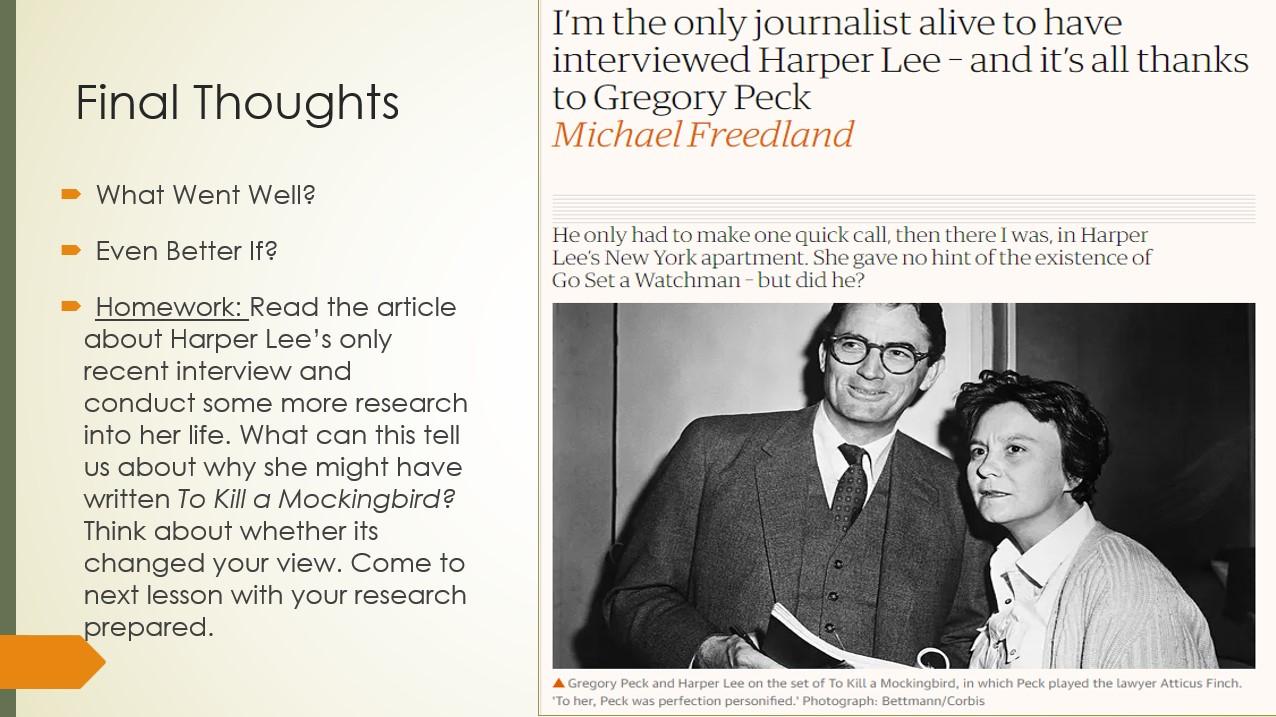
Attachments:
You must be logged in to view attached files.-
at 13:45 #25018
-
-
at 03:52 #25107
Diana
ParticipantHere’s my homework, sorry updated it late, there’s some issue with my computer
Attachments:
You must be logged in to view attached files.-
at 18:22 #25119
-
-
at 13:36 #25111
Beth
ParticipantSummary for Lesson 2
In today’s lesson we continued our study of To Kill a Mockingbird by Harper Lee. The powerpoint with all of the resources is attached below, which can be used to help plan and write the homework. The powerpoint contains our work on digging deeper into the style and form of the novel, thinking about the moral of the story, author’s intent, and genre. The class worked brilliantly today, identifying the moral of the story beautifully and thinking deeply about how to communicate these ideas. They also dealt with the notion of genre fantastically, and were able to analyse, interpret and re-imagine the book through the lens of different genre conventions. We discussed three central genres that the book plays upon: Southern Gothic, courtroom drama and Bildungsroman, which the students had a great understanding of. I really enjoyed hearing their thoughts on what genre they would re-write certain scenes in- excellent work today everyone, really well done and I’ll see you next week
Here is the video on Southern Gothic: https://www.youtube.com/watch?v=9VzRhVLxlGU
Homework
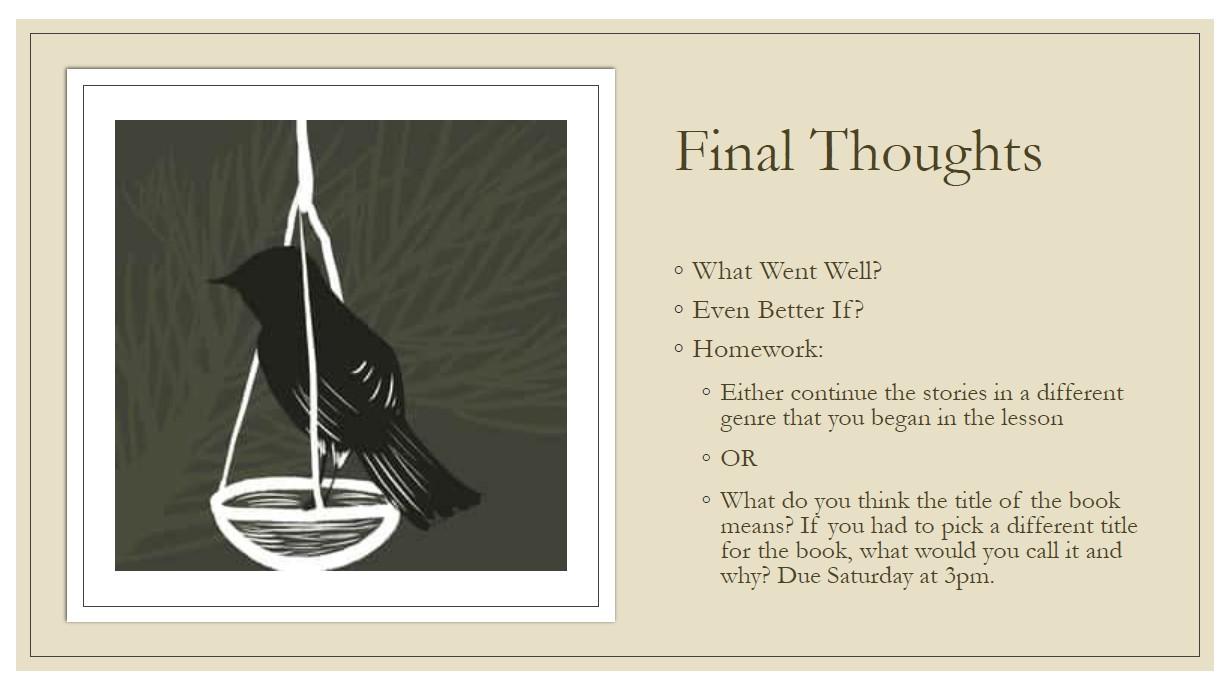
Attachments:
You must be logged in to view attached files.-
at 14:10 #25234
-
-
at 03:00 #25186
Diana
ParticipantHere’s my homework, please check
Attachments:
You must be logged in to view attached files.-
at 10:23 #25213
-
-
at 13:47 #25228
Beth
ParticipantSummary for Lesson 3
In today’s lesson we concluded our study of To Kill a Mockingbird by Harper Lee. The powerpoint with all of the resources is attached below, which should be used to help plan and write the speeches assigned for homework. The powerpoint contains our work on some of the deeper and more complex ideas in Harper Lee’s writing, focusing on symbolism as a framework with which to understand the book. We looked at how important symbols are in this novel, focusing firstly on the eponymous mockingbird and then expanding out to understand how Lee elucidates her themes through the use of symbols and references. The students came up with fantastic examples of their own symbols that could communicate thematic ideas to the reader. We then discussed the key notion of justice in the novel, thinking about how to relate this to historical events of the time and analysing judicial opinions from 1944 to give some context to how our own notions of what is just and unjust may shape the way we read the book. They conducted this beautifully, with real depth of thought, maturity and sophistication, and I was incredibly impressed with all of their work today. Really well done class you have worked brilliantly today and I was so pleased with all of your work and discussions. See you next week!
Here is the video on symbolism: https://www.youtube.com/watch?v=GR9VbSXxouM&t=2s
Here is the video on symbols in the novel: https://www.youtube.com/watch?v=BzhAHrgppzY
Here is the video on the Scottsboro Affair: https://www.youtube.com/watch?v=k_q4GG3iHGY
Homework
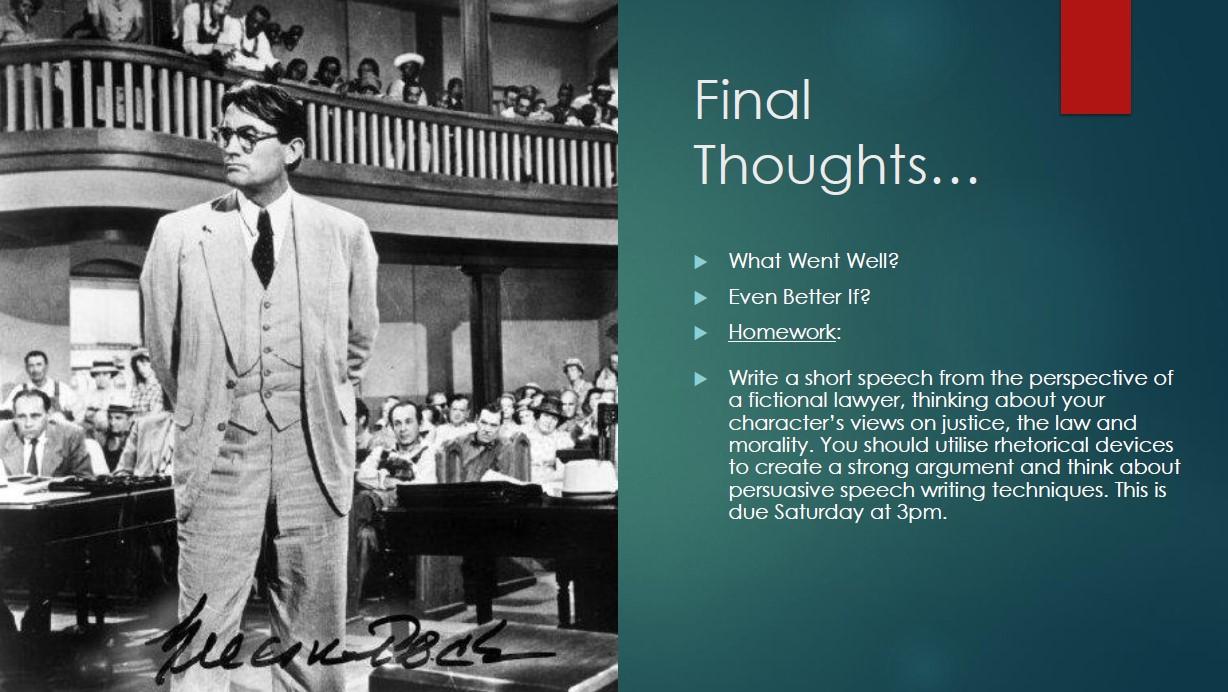
P.S. The speech from the lawyer I said you could read to help you with the homework is on page 215-220 of the PDF I have attached below (the one titled Teaching Mockingbird).
Attachments:
You must be logged in to view attached files. -
at 13:38 #25357
Beth
ParticipantSummary for Lesson 4
In today’s lesson we began studying The Great Gatsby by F. Scott Fitzgerald. The powerpoint with all of the resources is attached below, which should be used to help plan and write the paragraphs assigned for homework. The powerpoint contains loads of information on the context of The Great Gatsby, considering the crucial contextual ideas of the Roaring 20s in America and the American Dream. It also contains our thoughts on the key themes and motifs within the novel, and our discussion on how the novel deals with the concepts of wealth inequality and social class. Everyone worked brilliantly today, we had a great discussion about our favourite and least favourite things about the book, in which students successful picked out the most interesting and enlightening features of the novel. The class offered some really excellent insights into whether or not they considered the book to be an example of social satire and gave some excellent reasons backing up their opinion, and we also had a very interesting discussion about the way Fitzgerald may have perceived the society he was presenting in the novel. Really fantastic work today class as ever- really well done and I’ll see you next week
Context in Gatsby video: https://www.youtube.com/watch?v=1XM30FUke5U
Homework
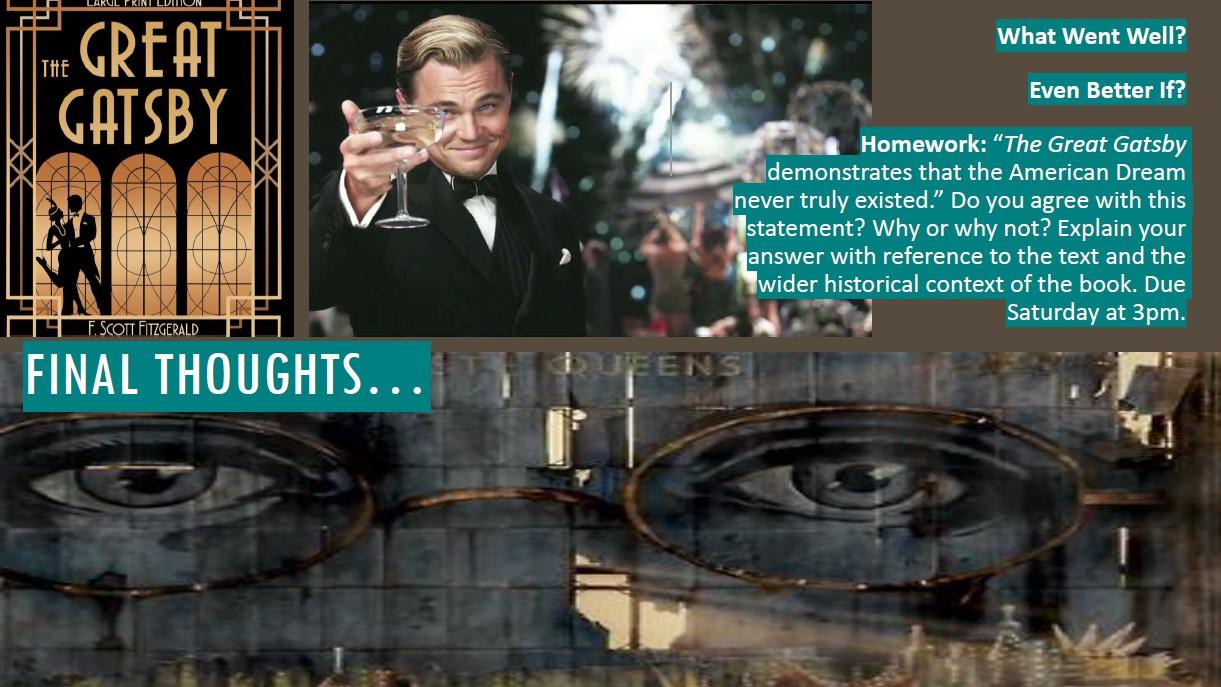
Attachments:
You must be logged in to view attached files. -
at 13:34 #25470
Beth
ParticipantSummary for Lesson 5
In today’s lesson we continued studying The Great Gatsby by F. Scott Fitzgerald. The powerpoint with all of the resources is attached below, which should be used to help plan and write the paragraphs assigned for homework. The powerpoint contains all our thoughts on the style and narrative of the novel, focusing particularly on the role of symbolism and the genre of tragedy and how this relates to the book. It contains thoughts on character analysis, the theory of Nick as the unreliable narrator and the students’ analysis of tragic elements within the book which they completed fantastically. We had a really great discussion on the concept of time within the book, analysing the symbolic importance of the scene where Gatsby and Daisy see each other again for the first time. The students also shared some interesting ideas on whether the characters in the novel are well-rounded or more two-dimensional and how they represent different themes within the story. I really enjoyed hearing everyone’s opinion on Gatsby’s status as a tragic hero and his hamartia, or ‘tragic flaw’, and thought that the way they conceived of Nick’s narration and its trustworthiness was outstanding. Fab work class- keep it up and I’ll see you next week
Tragedy video: https://www.youtube.com/watch?v=eVRU5MVYNiw
Homework
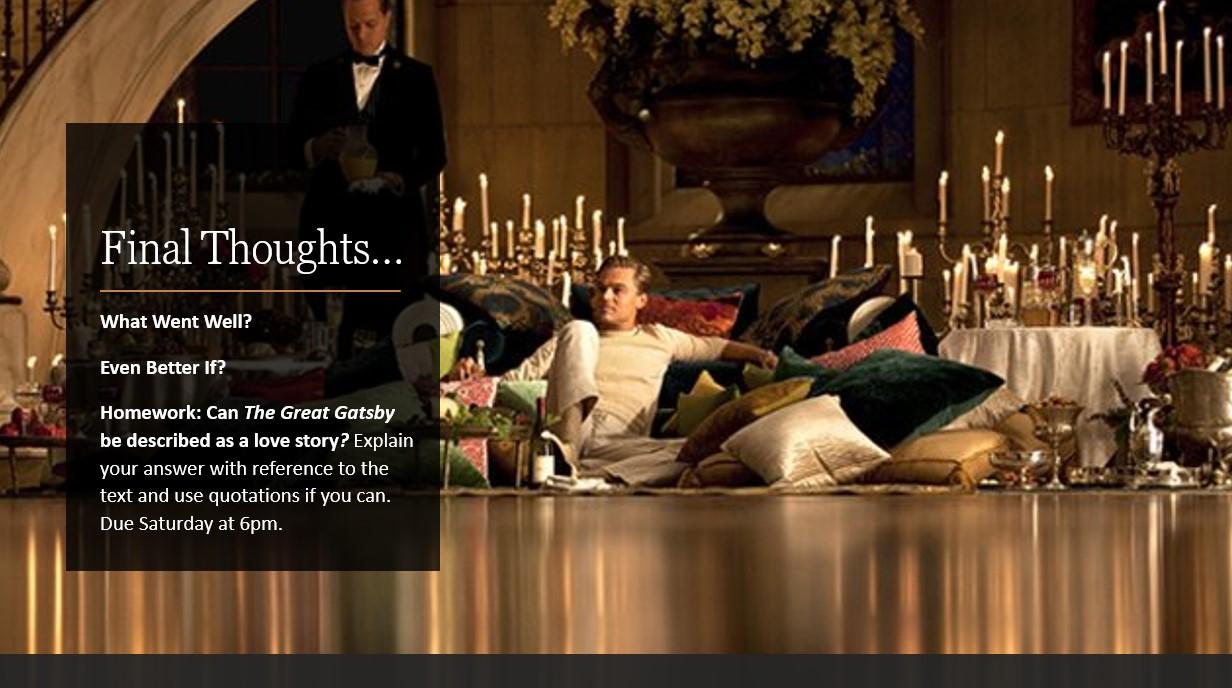
Attachments:
You must be logged in to view attached files. -
at 13:37 #25588
Beth
ParticipantSummary for Lesson 6
In today’s lesson we concluded our study of The Great Gatsby by F. Scott Fitzgerald. The powerpoint below contains our work on the close textual analysis of The Great Gatsby, focusing in particular on elements such as the importance of symbolism in the novel, the symbolic importance of the deaths of both Gatsby and Myrtle, the ideas of class and consequence prevalent in the novel, and Fitzgerald’s final reflection on the validity of the American Dream. The students all worked fantastically hard today, we had some really insightful, interesting and imaginative contributions from everyone on the three symbols we studied closely this lesson: the green light, the eyes of Dr Eckleburg and Myrtle’s death. I was super impressed by the creativity and thoughtfulness the class demonstrated in discussing these themes, and also really enjoyed hearing their 1920s newspaper reports that reflected the prejudices of the time. Really well done everyone, I have been so impressed with your work on this book and you should all be proud of yourselves. See you next week!
Homework
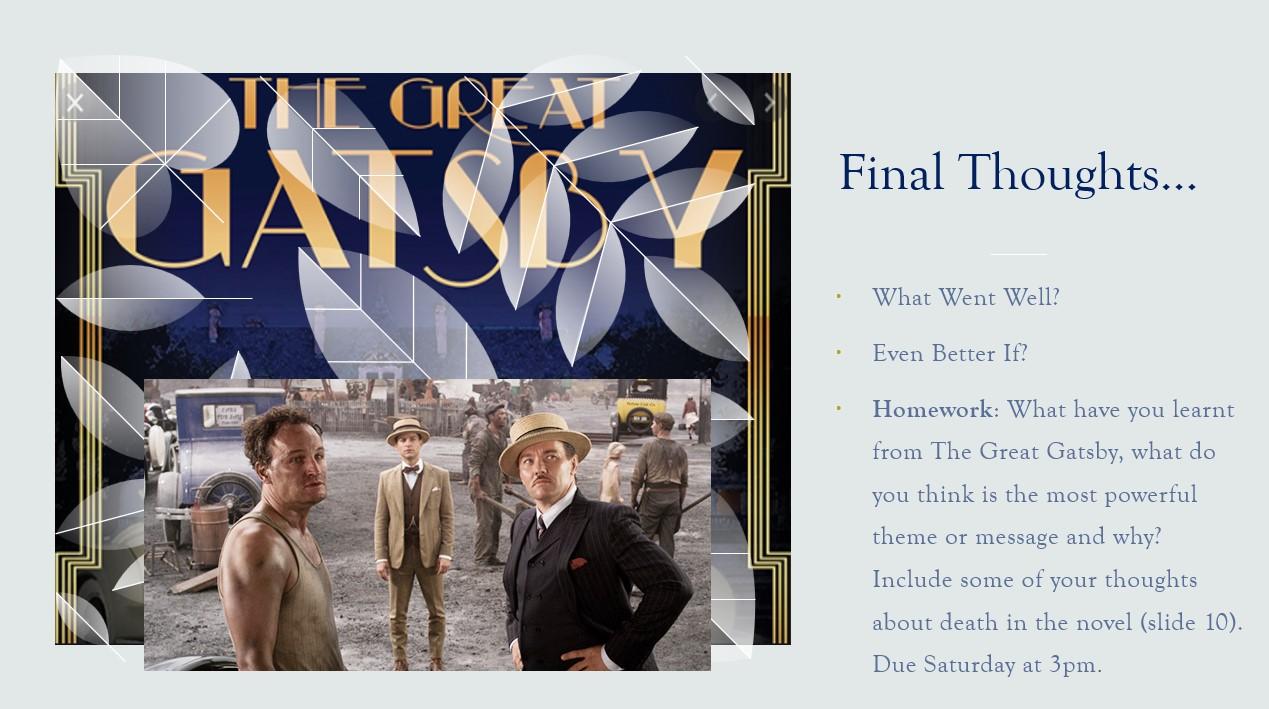
Attachments:
You must be logged in to view attached files. -
at 13:31 #25677
Beth
ParticipantSummary for Lesson 7
In today’s lesson we began our third book, The Hunchback of Notre Dame by Victor Hugo, learning about the historical context and ideas that the book reveals about the time of its publication. We began by discussing our likes and dislikes within the book before talking about the historical context of both the late 1400s (when the book is set) and the early 1800s (when the book was written). We learnt about France’s gothic past, thought about how understanding Hugo as an author could help inform our understanding of the novel, and spoke about the background of the 1789 French Revolution. Finally we spoke about stereotypes and where these appear in the novel, before completing a creative writing task where the class had to put themselves in the shoes of someone from that time period in France using everything they had learnt about the history. Great work today from the class- really attentive and thoughtful work today everyone, well done. See you next week
Homework
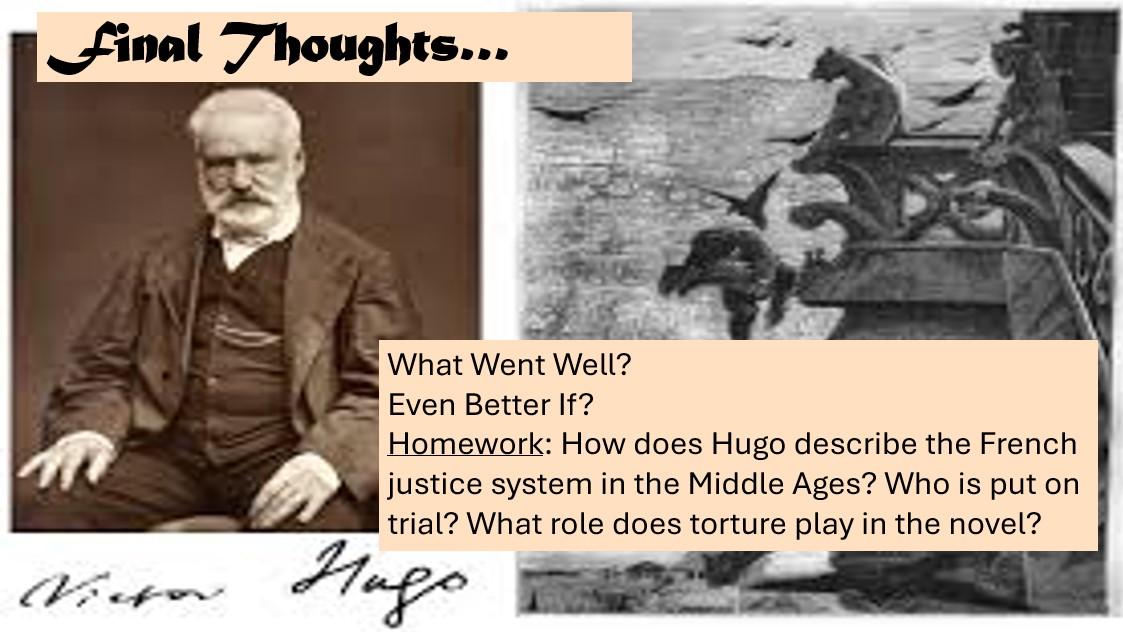
Attachments:
You must be logged in to view attached files. -
at 13:34 #25823
Beth
ParticipantSummary for Lesson 8
In today’s class we continued our work on The Hunchback of Notre Dame, thinking today in depth about narrative within the novel and how that can reflect societal norms and opinions of the time. We began by discussing the perspective the story is told from, thinking about the notion of the unreliable or biased narrator and how to separate this concept from that of author’s voice. The class then analysed examples from the book where the narrator appears opinionated or non-neutral with regards to the events- and the students then created their own narrator characters to match these ideas. Finally we looked in depth at an article about the book written by a Roma author considering the way both Roma people and women are presented by this narrator and how this can be read alongside theories about race and gender stereotypes in the book. Fab work from the class today, they completed some great work on narrators in particular and were quick to pick up on the pop-lesson we did on roman numerals. Keep it up everyone, excellent job
Homework
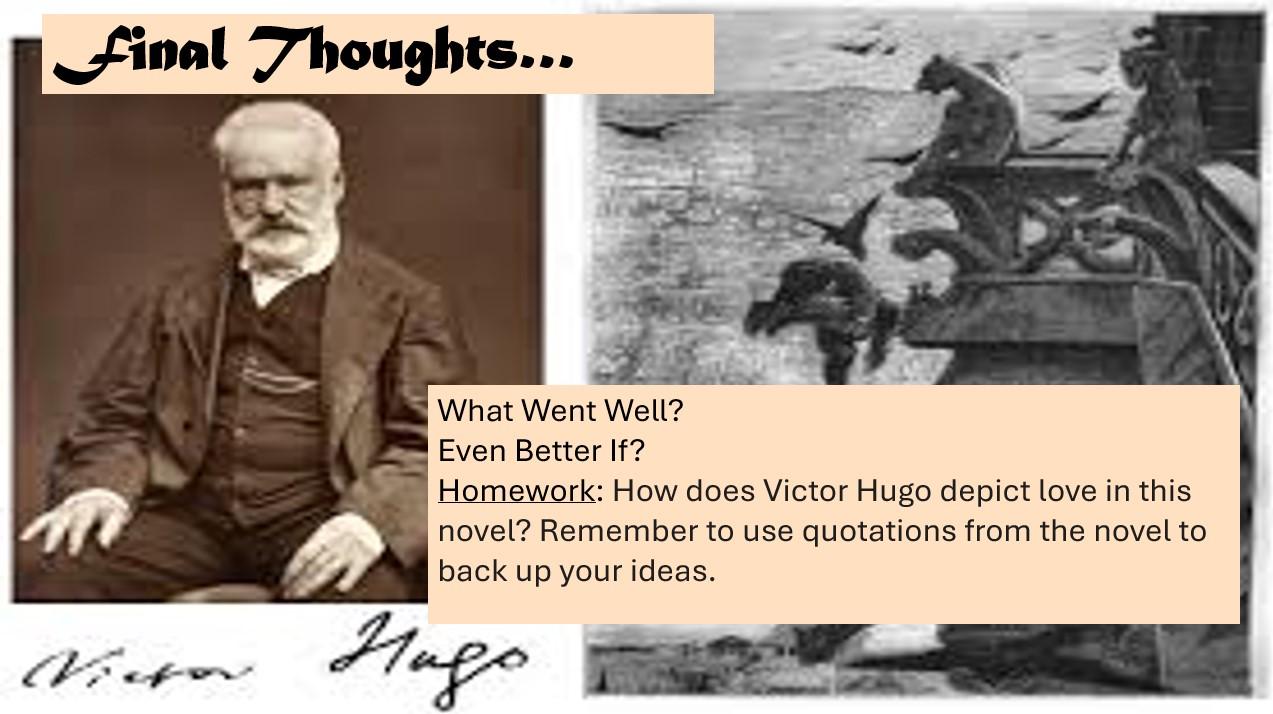
Attachments:
You must be logged in to view attached files. -
at 13:22 #25936
Beth
ParticipantSummary for Lesson 9
In today’s class we finished our work on The Hunchback of Notre Dame, considering some core concepts of the novel such as the role of protagonist/ antagonist divides and the concept of free-will. We began by speaking about Frollo and whether we could consider him a typical villain, using an essay to expand our ideas. We then spoke about the philosophical concept of free-will and predetermination, linking ideas on this to the characters and plot of the novel and answering some comprehension style questions on these themes. Finally the class completed some creative work on setting, thinking about the centering of Notre Dame in Hugo’s novel, and considered some final debate questions to conclude our work on this book. Good work from the class today- they were able to critically evaluate the essay we studied together fantastically and gave some fab contributions on the topic of setting and fate too, particularly with reference to the comprehension style questions they wrote answers for. Lovely work today everyone, well done and I’ll see you for our next book next week
Free-will video: https://www.youtube.com/watch?v=HYWiIWpcCIM
Homework
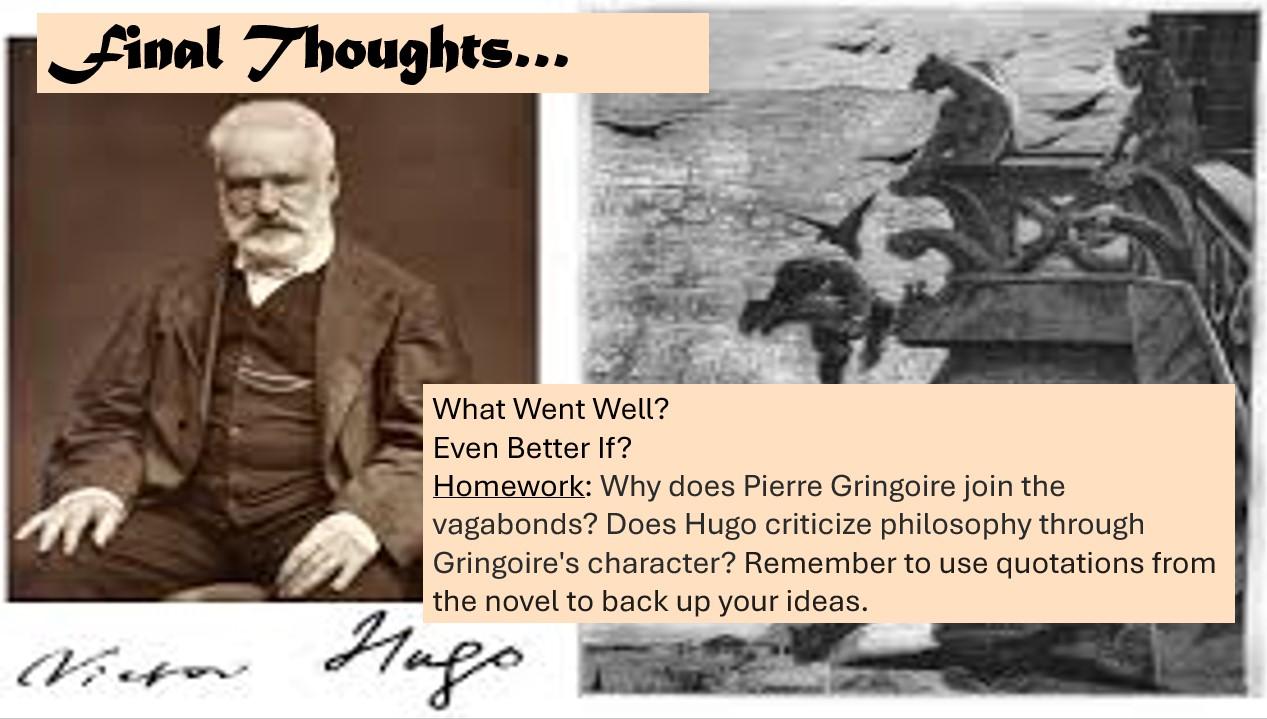
Attachments:
You must be logged in to view attached files. -
at 13:52 #26044
Beth
ParticipantSummary for Lesson 10
In today’s lesson we began our study of The Book Thief by Markus Zusak. The powerpoint attached contains lots of ideas on the historical context of the novel and how crucial an understanding of Nazi Germany and the Holocaust is in understanding the events of the book. We spoke about the theme of book burning in the novel, and why it is such a recurrent event throughout history, thinking about what the burning of books represents on a deeper level and considering this in relation to Heinrich Heine’s famous quote on the subject. We discussed the Orwell quote “whoever controls the past controls the future, whoever controls the present controls the past” and the class did a fantastic job of linking this quotation to the ideas explored in the novel about the power of knowledge and history. We then looked at the irony of the book’s title and finally the class wrote some fantastic one-sentence summaries of the novel, thinking about the role of education and literature within it. I was really impressed by the extent of their knowledge about Nazi Germany and how maturely and sensitively they were able to deal with some very complex and troubling ideas surrounding the Holocaust. Excellent work today everyone, I am really impressed with you all. You dealt with some really difficult and challenging themes this lesson and did so beautifully and articulately. Well done and see you next week
Homework
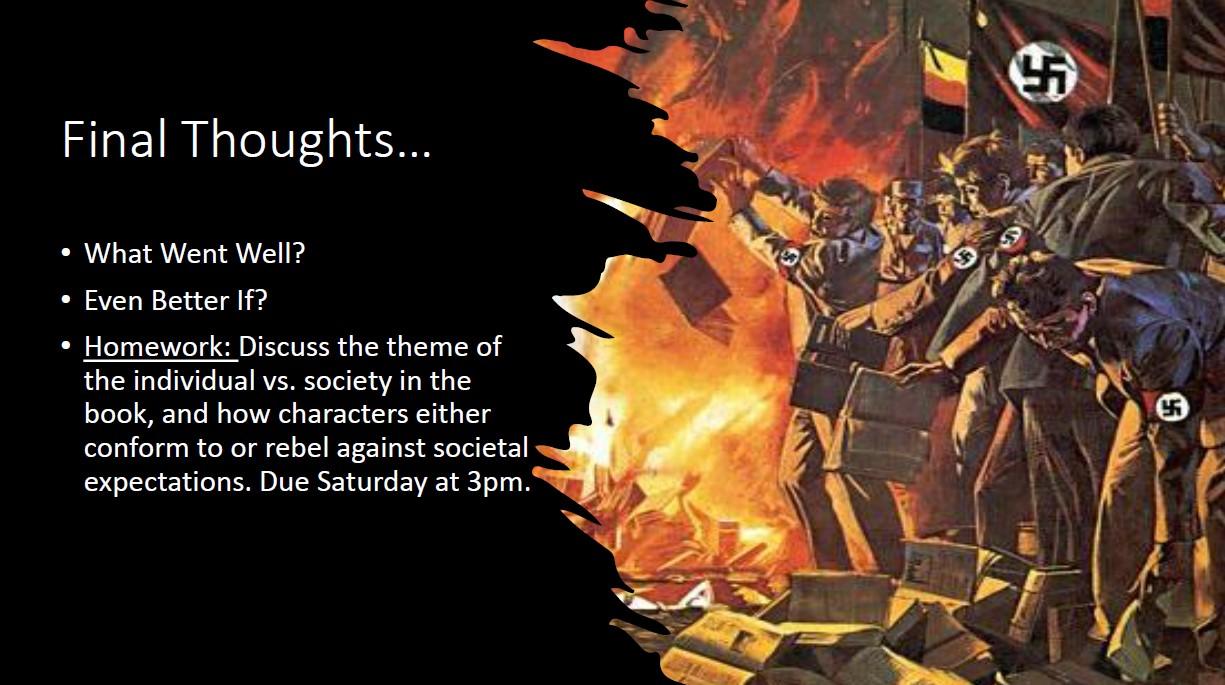
Attachments:
You must be logged in to view attached files. -
at 13:46 #26172
Beth
ParticipantSummary for Lesson 11
In today’s lesson we concluded our study of The Book Thief by Markus Zusak. We began by discussing the concept of irony, discussing its use throughout the book and conducting some close text analysis of ironic passages from the novel. We then moved on to talking about author intent, thinking about why Zusak had made the choices he made in the novel and what could be inferred from this. The class completed an interview exercise beautifully, and also watched and analysed a real-life interview with Zusak for comparison. We thought about the perspective of the novel, comparing the presentation of Death to our expectations, and then the class emulated the narrative voice of the novel through writing their own scenes narrated by Death. Finally, we discussed the moral of the story, using a series of interesting quotations from the book as a guide, which the students encapsulated in a very lyrical and poignant way. The class worked beautifully today, I was super impressed by the originality of their ideas and their dissection of the way Zusak conceptualises Death. We have had some really wonderful writing, debating and creative output from everyone in the class over the past eleven weeks and I have been wowed by their progress and abilities. Keep up the brilliant work everyone and see you soon
Here is the link for the video we watched on the role of Death in the novel (it also has a blog post attached which is worth a read!): https://www.ignitedinkwriting.com/ignite-your-ink-blog-for-writers/read-the-book-thief-by-markus-zusak/2017
Homework
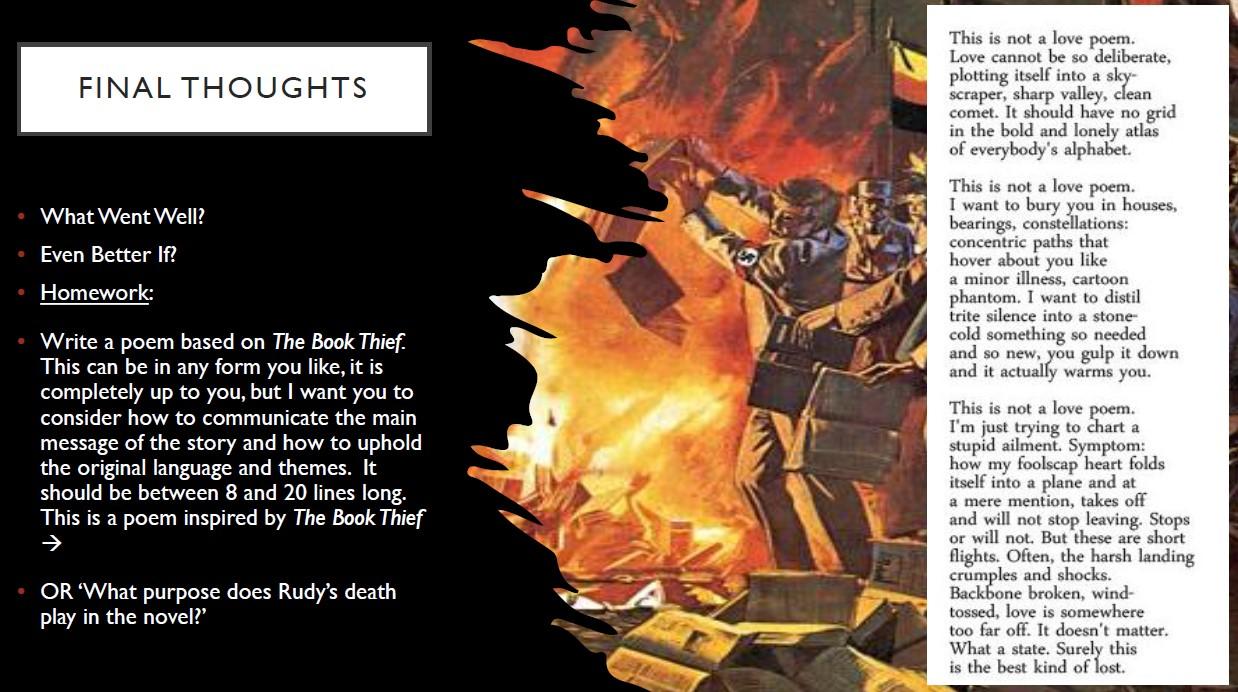
Attachments:
You must be logged in to view attached files.
-
-
AuthorPosts
- You must be logged in to reply to this topic.

